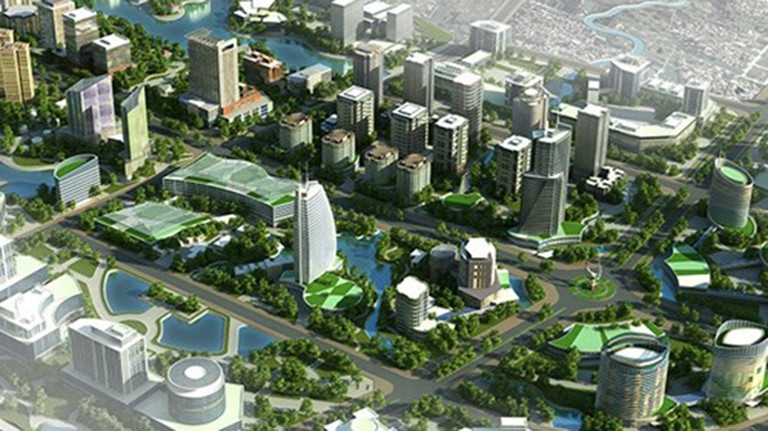 |
| A view of the Hoa Lac High Tech Park. Plans have been submitted for the park to become a high tech centre of the whole country. The park has attracted 94 projects, many of them belong to high ranking domestic and foreign economic groups. — VNA/VNS Photo Huy Hung |
What is the current status of the Lang Hoa Lac High Tech Park?
The Lang Hoa Lac High Tech Park has attracted 94 projects with total registered capital of VND89.3 billion (US$3.9 million), of which 52 projects are already in operation.
Among these projects, many of them belong to high ranking economic groups from Vietnamese and abroad, including the Japanese Nidec and Nissan Techno economic groups, the Vietnam-South Korean Science and Technology Institute, the Viettel Corporation, Vietnamese Post and Telecommunications (VNPT), Vingroup, FPT and others.
The Lang Hoa Lac High Tech Park is now the home to some 9,000 students and 13,000 workers who are learning and working there. In addition, the park has also an R&D network specialised in the fields of information technology; telecommunication software; bio-technology; auto technology and others. In addition, high-tech equipment and spare parts are also manufactured there.
Last but not least, right now a start-up ecology is being established in the Lang Hoa Lac High Tech Park. Hopefully, in the near future, the park will become a venue attracting resources needed to create a national park.
How will the Lang Hoa Lac High Tech Park attract big investment?
The two most important criteria for any project to be established in the park – it must be in the field of high tech and its products are high tech. The requirements are already stated in the Vietnamese law. In the course of selecting investors, the park owner has come up with a rule “3 high’s: high in technology; high in investment capital and high in added value” and “3 low’s: low in environmental impact; low in the requirement of the labour force and low in energy consumption and raw materials”.
What has been achieved in the Lang Hoa Lac High Tech Park is worthy of note, yet it has not yet met the set objectives. Why?
There are various reasons. A leading reason is that its infrastructure has not yet been completed. This has somehow affected the attraction of high-quality human resources to come and work in the park. Another factor which is also very important is the slow process of land clearance.
Right now, the Lang Hoa Lac High Tech Park is in the process of selecting the most suitable projects to invest in the park, like universities; research projects and businesses whose financial support comes from the Government.
One of the key objectives of the Lang Hoa Lac High Tech Park is to formulate new high-tech to contribute to national socio-economic development and to provide high tech skilled workers to the labour market.
What should we do to make the Lang Hoa Lac High Tech Park a good nursery for high tech in Vietnam?
The park will have to have the latest high-tech infrastructure meeting demands from the investors while expanding co-operation with other universities, research institutes and enterprises from inside and outside Vietnam.
One of the key missions is that the Lang Hoa Lac High Tech Park will become a venue for science and technology activities through organising more training courses and research activities. In addition, the park will further complete its utility services to meet requirements from its clients. VNS/Hanoimoi

Barriers keep foreign investors away from Vietnam’s high-tech parks
Experts suggest that to increase the attractiveness of the high-tech parks, together with effective special incentives, the high-tech parks should have a dynamic working environment, and modern and synchronous infrastructure.

Four million-dollar projects land in Hoa Lac Hi-tech Park this year
The Hoa Lac Hi-tech Park is currently home to 91 projects which have combined investment approvals of over VND85.8 trillion (nearly US$3.7 billion).
 Tran Dac Trung, deputy director of the Lang Hoa Lac High Tech Park, speaks on the park’s plan to become a tech hub in Vietnam.
Tran Dac Trung, deputy director of the Lang Hoa Lac High Tech Park, speaks on the park’s plan to become a tech hub in Vietnam.